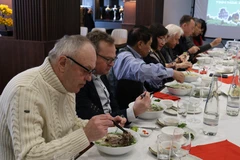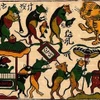Thua Thien-Hue (VNA) - With a long renowned cuisine and various promotional activities, Hue’s dishes are known for their mouthwatering taste and meticulous way of cooking.
Meticulousness of Hue cuisine comes all the way from ingredients selection to dish decoration, which has always attracted people’s attention when visiting the former capital of Vietnam.
More than 1,700 Hue-style dishes are being preserved at present. Hue is best known for elegant royal cuisine, which was served to kings under the Nguyen dynasty (1802-1945).
Hue city, which has long been known as the only place in Vietnam that has royal dishes, has striven to become the capital of gastronomy in Vietnam.
One distinctive quality of Hue food is the harmonisation of yin and yang in each dish. For example, molluscs are always cooked with chilli, pepper, lemongrass and grapefruit leaves, "hot" spices that balance the "cool" features of the water-based creatures.
Various snack-like items, such as ‘banh beo’ (rice cake with grilled shrimp), ‘banh nam’ (flat steamed rice dumpling), ‘banh bot loc’ (dumplings with shrimp), and ‘banh canh’ (cake soup), to name but a few, are a major part of the Hue cuisine.
Visitors can find these items at Hue restaurants in Hanoi and Ho Chi Minh City. ‘Bun bo Hue’ (spicy beef noodle soup), a local breakfast dish, is also popular around the country.
Some Hue dishes have been listed as the country’s best foods by Vietnam’s Record Book such as bun bo (beef noodles), com hen (rice with mussels), banh beo (rice cake with grilled shrimp), banh bot loc (dumplings with shrimp), banh khoai (fried rice crepes), ruoc (shrimp paste), me xung (sesame candy), che hat sen (sweet lotus seed pudding), tom chua (pickled shrimp), and thanh tra (a grapefruit variety that was served to the king).
Meticulousness of Hue cuisine comes all the way from ingredients selection to dish decoration, which has always attracted people’s attention when visiting the former capital of Vietnam.
During Hue Festival 2018, restaurants within the city were bustling with both domestic and international diners. Many visitors revealed that cuisine is the magnet pulling them into the ancient city.
Myriad activities were being held throughout the event in order to promote the city’s one-of-a-kind cuisine, including Hue international food festival, royal gala dinner, and vegetarian food court, among others.
In addition to completing a dossier to recognise Hue as a food capital of Vietnam, Thua Thien-Hue province moves to build a culture and food museum in the imperial city.
Authorities of the central province of Thua Thien – Hue have unveiled a plan to invest more than 12.4 billion VND (542,500 USD), including 3.7 billion VND from the State budget and the remaining from organisations and individuals, to build a brand name for Hue dishes in 2018-2020.
The move is significant as many Hue dishes, which are now available in the market, are inauthentic because they are not prepared in a proper way and with wrong ingredients, causing the false tastes.
Last year, the provincial Department of Tourism signed a cooperation memorandum with Dai Nam – Thai Y Vien, a local company focusing on areas like food and tourism. The provincial People’s Committee, which authorised the department to sign the memorandum, said the signing was the first move towards implementing the plan; however, it did not reveal the actual works of the document.
The provincial authorities also gathered some of the country’s leading gastronomy researchers at a conference to discuss ways to utilise the food culture of Hue to develop tourism.
Under the plan, Hue cuisine would have its signature while the city’s specialty dishes would get their own trademarks. Authorities, researchers and businesses would work closely to develop the brands.
Restaurants and eateries around the city serving authentic Hue dishes would put up signature boards for visitors to recognise them.
The Department of Tourism would brainstorm tour programmes that offer tourists a chance to taste and explore local cuisines. Those visitors would be able to visit lagoons and farms where ingredients for local dishes are harvested. Then, they could observe the preparation and cooking process.
Some programmes would allow tourists to lend a hand in growing and harvesting vegetables in the farms or go shopping for ingredients in local traditional markets.
They would also get chances to go further in studying Hue’s gastronomy by sampling local folklore-style, royal-style and vegetarian food.
The plan also included an ambitious proposal to construct a food museum, which would offer a study space, a display space and an area to watch culinary performances and buy food.
As the former capital of the country’s last monarchy, the Nguyen Dynasty, Hue is already a centre of Vietnamese gastronomy due to the fact that top chefs from different regions of the country moved there to serve the royal family. Today, the city is known as the home of almost 1,700 of the country’s 3,000 dishes./.



























